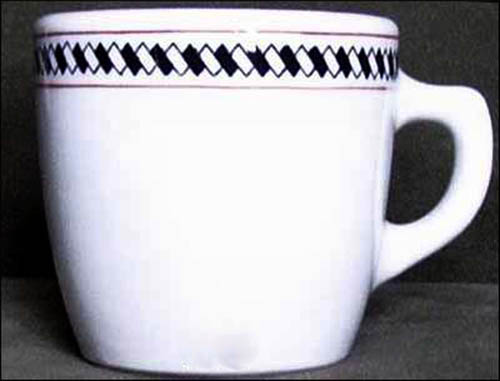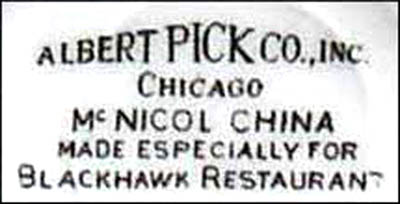Manufacturer: McNicol China
User: The Blackhawk Restaurant
Pattern Number: P.L. 3009-17-22-17
Distributor: Albert Pick & Co., Inc., Chicago
Date of cup: unknown
Notes: Otto A. Roth opened The Blackhawk restaurant in December 1920 at 139 N. Wabash and Randolph in the Chicago Loop. One of Chicago's most successful restaurants, spanning 64 years, the original restaurant continued operations under the Roth family until August 31, 1984.
The Blackhawk of the 1920s was elegant with its 600-seat dining room main floor and magnificent murals, wood panels and crystal chandeliers. At that time, the venue focused on fine cuisine with a small string ensemble playing from a small balcony. There was also a men's rathskellar downstairs — a grill where lower priced meals were served quickly at counters and tables.
In the Jazz Age of the 1920s, Otto Roth shifted from waltzes to the big dance orchestras, and in September 1926, he booked the young dance band, Carlton Coon-Joe Sanders and their Kansas City Nighthawks to play for two seasons. Success extended the orchestra's booking into the next five years at The Blackhawk.
According to John Drury, author of Dining in Chicago (1931): "If you like to dance between the soup and the entree (which epicures claim is bad practice), we recommend the Blackhawk, at the east end of the bright light area (139 North Wabash Avenue); across the street from Marshall Field's department store. Here is a luxurious dining room where the food and the music are both of high order, and where you may see gay couples and couples not so gay, and have an all-around good time. Coon-Sanders orchestra will tickle your toes if nothing else will. Dancing is from 6:30 PM to 1:30 AM and there is no cover charge at any time. They serve a $1.50 table d'hote dinner that meets with the a approval of most Blackhawk patrons."
Many orchestra leaders and musicians found fame at The Blackhawk, including Ted Weems with Perry Como, Hal Kemp, Kay Kyser, Bob Crosby and his Bob Cats, Ozzie Nelson, Jack Teagarden, Les Brown and Mel Torme to name a few.
Later, when radio became popular in the 1930s, Otto Roth sponsored broadcasts directly from The Blackhawk, making it known for its entertainment. The Blackhawk survived Prohibition and the Great Depression years because of its entertainment.
In 1938, Don Roth took over the restaurant's operation after his father had a heart attack. At that time, Don Roth hired managers to operate the restaurant while he served in the Marine Corps. He then returned to The Blackhawk as owner-manager in 1945, one year after his father died.
As the big band era faded in the early 1950s, Don Roth shifted The Blackhawk's focus from entertainment to food. Catering to business executives, the restaurant food focused on serving large portions of meat, such as prime rib with potatoes and salads. In 1952, The Blackhawk was known as the venue "where food is the show" and Don Roth introduced his signature 21-ingredient spinning salad bowl, served with flare from a rolling cart.
Don Roth later expanded his business in 1969 by opening his first suburban restaurant — Don Roth's Blackhawk — in Wheeling, Ill., northwest of Chicago on North Milwaukee Road.
The original Blackhawk restaurant in downtown Chicago closed on August 31, 1984 and Don Roth's Blackhawk in Wheeling closed on December 31, 2009.
Sources:
Cornell Hotel and Restaurant Administration Quarterly, "Meeting Market Changes/Restaurant Merchandising," February 1973
Dining in Chicago, by John Drury, Copyright 1931
The Blackhawk, wikipedia
White body. Black and white print and red line border pattern.
For related info:
Blackhawk Restaurant by Bauscher Brothers
Blackhawk Restaurant / Indian Room by Shenango China
ID contributed by dbstoneware, kathleen and leontiev



